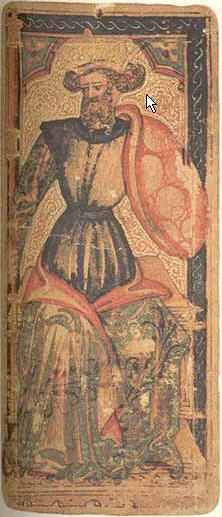Stuart Kaplan in his Tarot Encyclopedia presents the Rothschild cards on
page 120-122, he gives them as fragment of a late 15th/early 16 century Italian Tarocchi deck.
Their location is the Edmond de Rothschild collection in the Louvre in Paris, the cards
measure 189x90 mm. The fragment (according to Kaplan) consists of 8 cards: An Emperor, six
court cards (King, Queen, Knight and Page of Staves, Queen of Swords, King of Coins) and an
8th card, which couldn't attributed with security to any of the known motives of the
Tarocchi set. Kaplan considers it to be the Pope, the Old Man or the World - but no
suggestion did really meet the strange appearance. Kaplan speaks in this context also from
a single card from the Museo, Bibliotheka e Archivio di Bassano del Grappa, a Knight of Sword,
which is held by him as a card from the same deck with a size slightly different to the others:
190x90 mm.
The picture presents the Emperor in the Rothschild cards. It's one of
two cards in the Rothschild fragment, which might be considered to be trumps (the other trump
- Pope, Hermit or World according
to Kaplan, but a Jack of Coins and no trump to Dummett, is shown at the page of
Dummett's commentary).
The question might arise, if also the Emperor is not a trump, but a king of batons.
However, this doesn't seem possible, a King of batons in inside the other surviving cards, also
a King of coins (which also might suspected). A special difference are also the accompanying persons to the Emperor,
which are observable at other decks (for instance Cary Yale).
King of Batons
 |
 |

